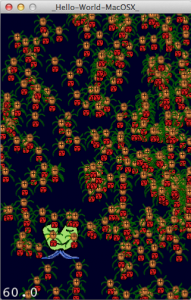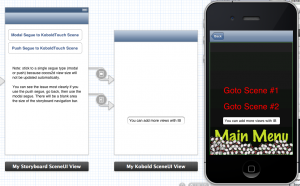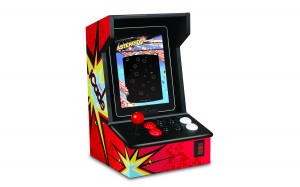This post will be unusually short because I’m going on vacation tomorrow (July 12th) and won’t be back before July 22nd.
I’ll use this post for a quick progress report on Kobold Kit.
Kobold Kit Progress
Kobold Kit is going more and more in a rapid-development direction, with fewer interruptions. Here’s the corresponding video to that:
It is also heavily gearing towards tilemap rendering and physics integration. We’re making a game with Kobold Kit which will become a Platformer Starterkit as well as a published game. It will also be featured in an upcoming book.
When I say we, I mean that a former colleague of mine (Marcus) has teamed up with me. He’s a game designer and Tiled user, so I get lots of good feedback on how to improve and move things in the right direction. You’ll see more of his work when we’re both back from our vacations in August.
The fact that I haven’t posted on the koboldkit.com blog for a week only means we were very busy making lots of smaller improvements to the platformer game we’re developing. I’ll be away for 1 week so I wanted to ensure that Marcus can get some work done while I’m away.
This is one other plus about this partnership: Kobold Kit will decouple as many tasks as possible from programming work and offload them to editing tools, configuration files and scripting. These improvements are beneficial to the programmers as well because they enable or speed up rapid prototyping.
And if you do happen to work with designers, your attention will not be required as often. If you haven’t done so in the past, you probably can’t appreciate what that means. But try anyway. 😉
Since Kobold Kit is so heavily integrated with Tiled, we decided to sponsor Thorbjørn Lindeijer and Tiled beginning August 1st. I also sent him my old Mac mini so he can setup daily builds for OS X.
We have also secured several sponsors ourselves, and we’re very excited about one in particular, but we don’t want to spoil the fun with a premature announcement. All in due time.
PS: In case you haven’t built the latest Tiled source code: you’re seriously missing out on the reworked properties pane (no longer a modal dialog). Here’s a OS X build of the Tiled source code (June 29th) if you want to give it a try. Thanks to Andreas Löw who built it for me.
KoboldTouch Update
I have received very little support or feature requests in the past weeks. I take this as a sign of maturity. At this point development on KoboldTouch is on hold until some time after the release of Sprite Kit (iOS 7). I will tend to serious bugs of course, and already made a compatibility fix for iOS 7 and Xcode 5.
I can’t say whether KoboldTouch will continue to incorporate cocos2d v3 or not. This depends on too many hard to predict variables:
Will cocos2d-iphone v3 be competitive compared to Sprite Kit and still used by a considerable number of developers? Will users be interested enough in an MVC framework with extras? Will cocos2d v3 perhaps take the chance and improve in ways that make KoboldTouch much less attractive? And how much or for how long is development time best spent (exclusively) on Kobold Kit, how much danger is there in splitting efforts?
I take a “wait and see” approach. The hope I have is that cocos2d will trim down its own API and copy the Sprite Kit API and behavior to become a natural, seamless “upgrade path” for Sprite Kit developers (drop-in replacement).
It won’t work any other way, or would you willingly switch from, say, MapKit to an open source alternative (route-me)? Only if you absolutely have to, am I right? Though the only “must have” feature that cocos2d will always offer over Sprite Kit requires an advanced skill set to exploit it in the first place.
But all of that is speculative at this point. If you’re a KoboldTouch developer or want to become one, you’ll get the support as always and you’ll be able to publish your game two years from now. That’s guaranteed.
As KoboldTouch user you’re also going to be Kobold Kit customers, I won’t charge KoboldTouch users twice. And if you want early access to Kobold Kit, sign up to Kobold Touch and check the forum. Since I can only unlock you manually you’ll have to wait until I’m back though.
Signing up to KoboldTouch now makes perfect sense because you’ll pay forever less than Kobold Kit customers, and it helps our efforts in more ways than just financially.
See you in 10 days!
Looking for a Sprite Kit Game Engine? Check out Kobold Kit!
Two weeks ago I blogged about Why Apple Created Sprite Kit and What It Means For Cocos2D.
Two weeks since WWDC 2013 is also a good time to take a first look at the impact of Sprite Kit on the economy. Everything and everyone seems to be in turmoil right now as far as 2D game development for iOS and related tools and services is concerned.
To understand the impact of Sprite Kit, let’s first look at Kobold Touch for which I have actual data to back up my impressions.
KoboldTouch Signup Rate - Bummer!
I have been taking notes of the exact days new KoboldTouch users signed up in an Excel sheet. I found it entertaining and thought that maybe some day I will have a use for it.
That day has come. I can present you the KT sign up rate from post-WWDC dates June 10th to 24th with the sign-up rate of the same two-week span in the preceding months: Continue reading »
KoboldTouch v6.2.2 is now available.
New features are a iOS Storyboard template project and support for Arcade controllers like iCade (all variants), GameDock (2 Players) and compatible controllers.
Storyboard Template
There are plenty of Storyboard + Cocos2D tutorials but none seem to get it quite right. After I wrote my Cocos2D Storyboard tutorial I went in for the kill, made it work with KoboldTouch and a couple improvements along the way, too.
One of the advantages of this Storyboard implementation is that you can return to a previous scene, continuing where you left off. You can of course also change scenes whenever you segue into a KoboldTouch scene. And you can have several KoboldTouch scenes side-by-side and differentiate easily which one was segue’ed into.
Here’s the KoboldTouch Storyboard Documentation which explains how to start a Storyboard project, which classes to use and the things that are different compared to a regular fullscreen KoboldTouch app.
Arcade Controller and Joypad Input
You may have heard of the iCade cabinet (pictured) to play arcade games like in the Arcade with joystick and 8 buttons. Maybe you already own one. And then there’s Kickstarter-backed GameDock, which features two gamepads for 2-Player action and HDMI output to your TV.
Here’s a quick demo of the iCade Core working with the (admittedly barebones) KoboldTouch arcade input controller demo:
iCade and GameDock are fun and exciting devices which already have hundreds of games supporting them! And those aren’t the only ones, there are several other Bluetooth joypad controllers compatible with iCade, like the Snakebyte idroid:con.
KoboldTouch makes it super-easy to use iCade, GameDock and compatible Bluetooth controllers!
A presentation about KoboldScript with a demonstration of a Tic Tac Toe game with Scene changes and transitions. You’ll see more KoboldScript code and learn more about its key concepts in this episode.
Episode #7 - Tic Tac To Lua
• KoboldScript Demo #2
o Tic Tac Toe
o Presentation
• iDevBlogADay: Donations
• Angry Ninjas Starterkit
 In this episode of LearnCocosTV I demonstrate how to write and animate a Cocos2D scene with KoboldScript.
In this episode of LearnCocosTV I demonstrate how to write and animate a Cocos2D scene with KoboldScript.
KoboldScript is more than just writing the same Cocos2D code but with a scripting language. Most other scripting language bindings for game engines simply translate the game engine’s C/C++/Objective-C API 1:1 (more or less) without introducing new concepts, adding more comfort by simplifying common tasks, or utilizing the powerful features of whatever the scripting language has to offer.
KoboldScript goes three steps further than that - one by tightly integrating the setup of scenes via defining the node properties in a tool-friendly tree structure (Lua table) that you can both write manually or create programmatically using Lua’s built-in features.
Two, by using Statemachines to drive game logic while also providing free Lua scripting via user-specified Lua callback functions. And three, by adding a (MVC-ish) component system with re-usable abilities and behaviors to all Cocos2D nodes.
Unfortunately I ran out of time at the end so I couldn’t even say goodbye. I hope you don’t mind. 
Episode #6 - One Small Script for Man …
• KoboldScript Demonstration
o How to create Scenes with Sprites, etc
o How Abilities & Behaviors work
• iDevBlogADay: Asynchronous Texture Loading
o Cocos2D Webcam Viewer speedup
LearnCocosTV is sort of like a personal sprint review presentation but in video form.
I think that just writing about what I’ve done recently would be rather dull, whereas a bi-weekly Show & Tell video would not only be more interesting, it is also much more encouraging for me to create something cool to show in the first place!
Each episode will update you about what I’ve done for or with Cocos2D, Kobold2D and iOS/OSX development in general, what I’ve learned in the process and what the end results are. Here’s episode one, I hope you’ll enjoy it:
LearnCocosTV - Episode 1: How I maed your Kobold
• Kobold2D 1.0 Released
• Kobold2D source code published on github
• First Kobold2D games published on App Store
• Kobold2D Server moved
• iDevBlogADay: How to use CCRenderTexture…
And no, I’m most certainly not going to run out of TV Show titles to vilify. 😀
PS: in case you’re wondering, the video was created with ScreenFlow 3.0.












